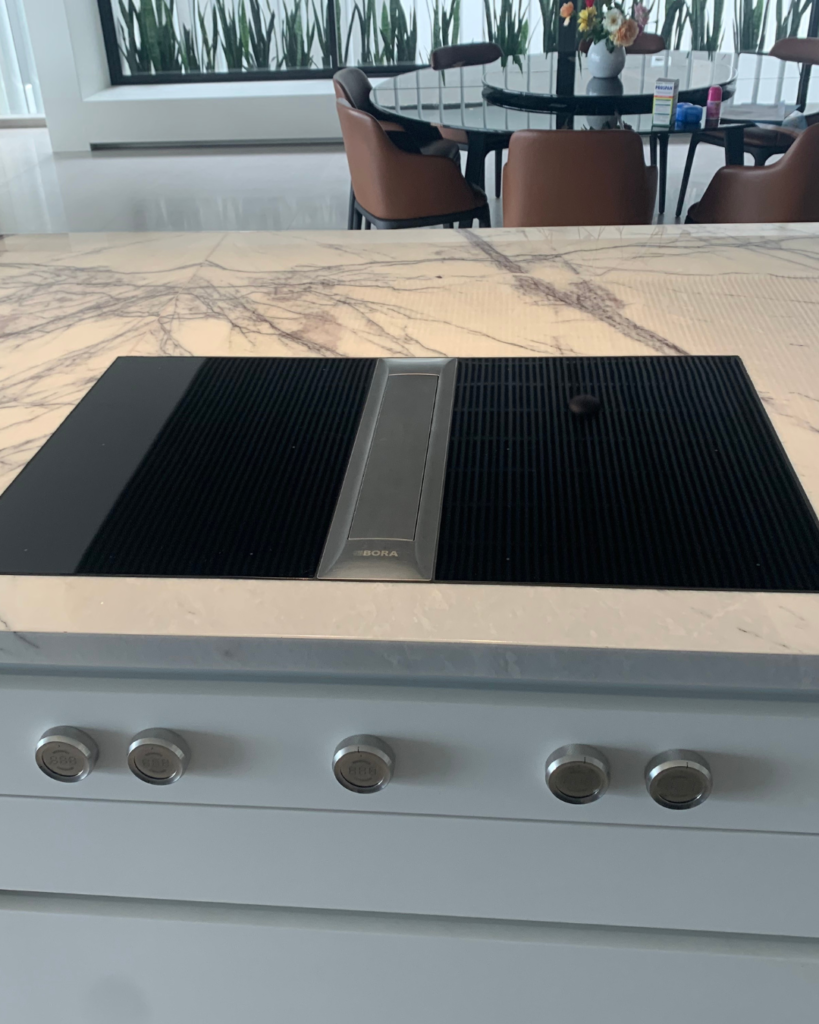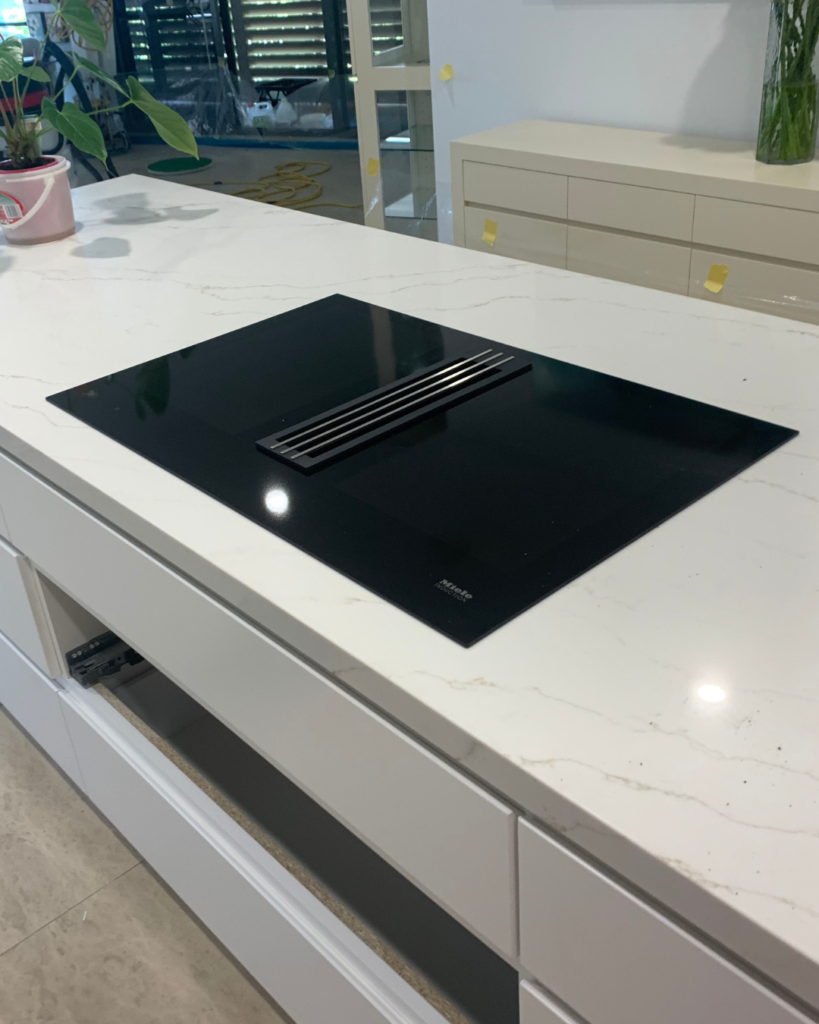Introduction
A rangehood is an essential kitchen appliance designed to remove smoke, odors, and airborne grease generated during cooking. Traditionally mounted above the cooktop, rangehoods typically use fans to capture and ventilate contaminants. However, downdraft rangehoods offer an innovative alternative by integrating directly into the countertop behind or alongside the cooking surface. Unlike conventional hoods, a downdraft rangehood can retract or “pop-up” when needed and discreetly disappear when not in use. This article explores the unique features, benefits, and considerations associated with downdraft rangehoods, helping you determine if it’s the right choice for your kitchen.
What is a Downdraft Rangehood?
A downdraft rangehood is a kitchen ventilation system installed into or behind your cooktop surface, designed to pull cooking fumes, odors, and steam downward instead of upward. Often referred to as a retractable range hood or pop-up range hood, it offers a minimalist, space-saving solution ideal for open-plan kitchens and kitchen islands where overhead installations aren’t practical or desirable. When activated, the hood rises above the countertop to extract smoke and steam efficiently, and once cooking is finished, it retracts seamlessly back into the counter.
Benefits of Downdraft Rangehoods
- Space-Saving Design: Downdraft rangehoods retract into the countertop, making them ideal for open-concept kitchens and island cooking areas, where overhead installations could obstruct views.
- Modern Aesthetics: Their sleek, minimalistic design complements contemporary kitchen styles without compromising functionality.
- Ease of Cleaning: Being retractable, these rangehoods allow easy access to filters and ventilation components, simplifying maintenance and cleaning.
- Flexible Installation: Downdraft rangehood vents can accommodate both ducted and ductless setups, offering versatile installation options suitable for various kitchen layouts.
- Improved Sightlines: Without an overhead hood, kitchen spaces appear more open and unobstructed, enhancing social interactions and aesthetic appeal.
Drawbacks of Downdraft Rangehoods
- Limited Extraction Efficiency: Due to the downward airflow, downdraft rangehoods may be less efficient at capturing smoke and steam from taller pots and pans compared to traditional overhead rangehoods.
- Installation Challenges: Downdraft rangehood installation can be complex, particularly when retrofitting existing kitchens, as it often requires countertop modifications and sufficient under-counter space for ducting or motor placement.
- Higher Cost: Typically, downdraft rangehoods and their installation may cost more than conventional rangehood setups due to additional structural and cabinetry modifications.
- Space Constraints: Under-counter installations can limit available storage space and may require careful planning to ensure compatibility with cabinetry and existing kitchen appliances.
Ducted vs Ductless Downdraft Rangehoods
Choosing between ducted and ductless downdraft rangehood systems depends largely on your kitchen layout, cooking style, and personal preferences. Each type offers distinct advantages and limitations.
Ducted Downdraft Rangehoods
A ducted downdraft rangehood system uses ductwork to vent kitchen fumes directly outdoors. The downdraft range hood vent typically requires installing ventilation ducts beneath the floor or through adjacent walls.
- Benefits:
- Highly effective at removing smoke, odors, and moisture directly outside.
- Superior ventilation efficiency, ideal for heavy or frequent cooking.
- Limitations:
- Complex installation, especially for retrofits or existing kitchens without pre-existing ducts.
- Higher upfront installation cost due to necessary ductwork modifications.
Ductless (Recirculating) Downdraft Rangehoods
Ductless downdraft rangehoods operate by filtering and recirculating air back into the kitchen using charcoal or carbon filters.
- How They Function:
- Air is drawn downward, filtered to remove grease and odors, and then returned into the kitchen space.
- Ideal Scenarios:
- Suitable for apartments or kitchens where ducting isn’t feasible.
- Ideal for kitchens with limited access to external walls or ceilings.
- Limitations:
- Reduced effectiveness compared to ducted systems, particularly for intense cooking scenarios.
- Frequent filter replacements required to maintain efficiency.
Best Downdraft Rangehoods
When selecting a downdraft rangehood, it’s essential to consider the various options available from reputable brands. Below is an overview of five notable manufacturers, highlighting their offerings, features, and standout models. All below were installed by Sydney Rangehoods.
Sirius Downdraft Rangehood
Sirius Rangehoods offer several top-of-the-range ducted downdraft rangehood models, including sizes of 580mm, 880mm, and 1180mm. Built with black glass fascia and stainless steel trim, these models offer powerful extraction, induction countdown control, remote functionality, and are a centerpiece in the kitchen. All models retract from the table. The standout model is the 1180mm Downdraft Rangehood, ideal for larger cooking spaces.
- Duct Options: Ducted Only
- Sizes: 580mm, 880mm, and 1180mm
Gaggenau Downdraft Rangehood
Gaggenau’ offer downdraft rangehoods that can be ducted or recirculating rangehoods and are designed to complement luxury cooktops and kitchens. Crafted from stainless steel, these hoods excel in extraction efficiency, operate quietly, and offer flexible installation options, including frameless or framed setups. They are perfect for premium kitchens and come in a range of different options that are both retractable and built inline with the cooktop. We love Gaggenau Rangehoods!
- Duct Options: Ducted and Ductless.
- Sizes: 900mm, 1200mm
BORA Downdraft Rangehood
BORA offers multiple models suitable for ducted and ductless installations, suited to pair with their range of high-end cooktops.. These rangehoods emphasize efficiency, quiet operation, and easy cleaning with dishwasher-safe components. The Professional 3.0 is particularly popular for its superior integration and extraction capabilities.
- Duct Options: Ducted and Ductless.
- Sizes: 900mm
Miele Downdraft Rangehood
Miele’s ductless downdraft systems are great for smaller kitchens or retrofits looking to minimize adjustments to their existing space, while making a serious upgrade to the extraction and aesthetic. Using charcoal air filters, combined with their 10 layer stainless steel grease filter, these systems clean and recirculate the air so their is no requirement for ducting. Equipped with features such as cooktop synchronization and Miele’s Eco Motor, they are a simple to install option that look great. Available in retractable and inline models.
- Duct Options: Ductless Only
- Sizes: 580mm
Downdraft Rangehood Quick Buying Guide
Use the straightforward checklist below to quickly determine:
- If a downdraft rangehood is suitable for your kitchen.
- Whether a ducted or ductless option best meets your needs.
Should You Buy a Downdraft Rangehood?
A downdraft rangehood is ideal if you:
- Have an island or open-plan kitchen layout.
- Prefer no visual obstruction above your cooktop.
- Have structural limitations preventing overhead installations.
Avoid a downdraft rangehood if you:
- Regularly cook with tall pots, producing heavy steam or smoke.
- Are limited in under-counter space required for installation.
- Want the strongest possible extraction performance.
Ducted vs. Ductless – Which Should You Choose?
Choose Ducted if:
- Your kitchen allows for ductwork installation (floor or wall).
- You require strong, direct extraction to outdoors.
- You cook frequently or produce significant smoke and steam.
Choose Ductless (Recirculating) if:
- Your kitchen cannot accommodate ductwork (apartment or rental).
- You prefer minimal structural changes and easier installation.
- You cook lightly to moderately and prioritize simplicity.
Conclusion
Downdraft rangehoods offer stylish, unobstructed ventilation ideal for modern kitchens, particularly island and open-plan designs. Deciding between ducted and ductless options depends clearly on your kitchen’s layout, cooking habits, and installation possibilities.
Still unsure? Sydney Rangehoods provides expert advice and professional downdraft rangehood installation. Contact us today to find the perfect solution for your kitchen.




